Because so much has been forced on us so rapidly in the last three decades, we seem have become averse to choosing change, especially in the public realm. For all the talk of innovation, there is much resistance to real change here.
By Shawn Selway
Published June 29, 2012
Visitors to the Waterfront Trust recreation compound at the foot of John Street are getting an unadvertised extra this month: a wall of steel that even the glibbest brochure writer would have trouble domesticating - though I suppose arts-inflected publicity could describe it as looking like the product of Serra + Kiefer. (Say, shouldn't someone be promoting this collaboration?)
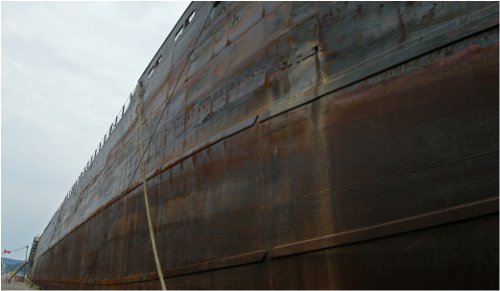
Not quite post-industrial Hamilton. The Algoma Provider docked at Pier 8 for refurbishing.
After the aestheticizing of industry and its traces is all done, however, there remains another, inside story to tell, and other cities are telling it to highly interested visitors.
Given our continual fretting that the conception of Hamilton held by others is not what we would prefer, perhaps we can learn from elsewhere how to cure ourselves of this embarrassing Skyway Syndrome - you know, the continuing low-level anxiety that people driving by on the Skyway are misled by the spectacle of smoke and flame and never come to appreciate our true Inner Beauty.
Although I have been a member of the Society for Industrial Archeology for going on fifteen years, I have attended only a few of their annual conferences.
These take place on the first weekend of June, and consist in a day of paper sessions and a day of "process tours" - that is, visits to factories, power plants, dam-sites and the like, where participants are shown the inside and the underside of a wide variety of industry and infrastructure.
Five concurrent tours were on offer at this year's get-together in Cincinnati. I opted for "upriver": the waterworks, an airfield, a bell foundry and a garage specializing in the restoration of antique racing cars.
Joining us on the bus were a few of the dozen or so members of the British Association for Industrial Archaeology, a senior organization in the network whose members are represented globally by the International Committee for the Conservation of the Industrial Heritage.
TICCIH, in turn, serves as special adviser on industry to the International Council on Monuments and Sites. The AIH people were on an extensive tour of American sites, and had connected with us for the weekend.
First up was the waterworks, where an expert on purification imparted the rudiments to half of our group while the rest were next door viewing the old pumphouse.
Cincinnati draws its water from the Ohio River, which is muddy and dirty. The mud and a few other things are cleared by sand filters. The rest of the ingredients are captured by activated carbon, a process which Cinci adopted early in North America.
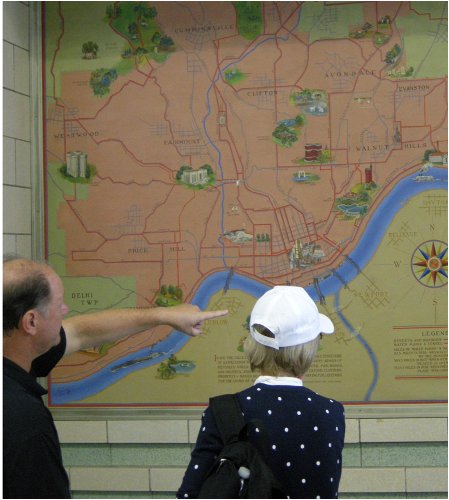
Seeing Cincinnati from the bottom up. Map of the water system in the filtration building.
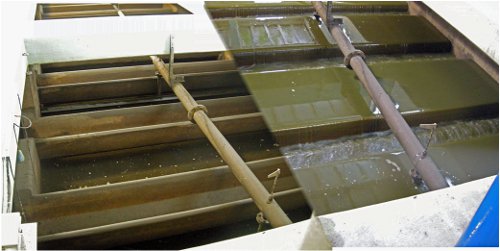
Sand filters, feed paused...then backflushing to clear the filter of accumulated sediments.
When it was our turn to see the pumps, we found them housed in a grand stone rotunda that caps a circular well four stories deep.
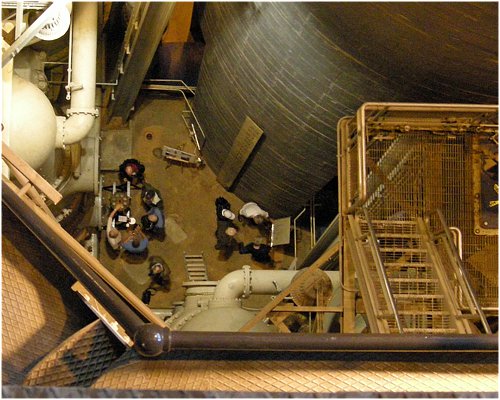
Cinci steam pumps
Water is conducted to the inlet side of the pumps via a tunnel cut through the bedrock below the riverbed. Triple expansion steam engines are mounted directly over the pumps to power them. Again we were divided, with some descending in a cage elevator to the pump floor, while the rest got an explanation of the engines from the retirees who are currently maintaining them in preservation.
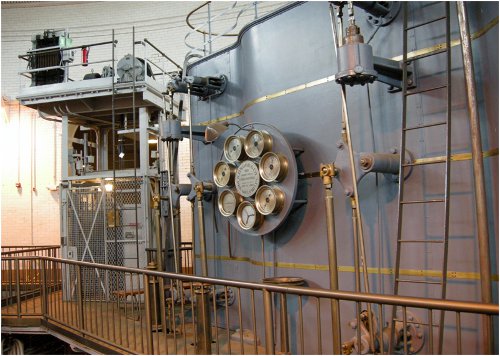
Triple expansion steam engines

Steam engine illustration
Cincinnati Lunken Airport's location in a basin eventually curtailed its expansion. It has now become a base for private jets, including the fleet of Procter and Gamble, which is the dominant company locally.
The terminal survived near total immersion in the great flood of 1937. Howard Hughes had a hangar here, and the pilot of the Enola Gay did his flight training at this field - which is as momentous a historical association as it is possible to have, I suppose.
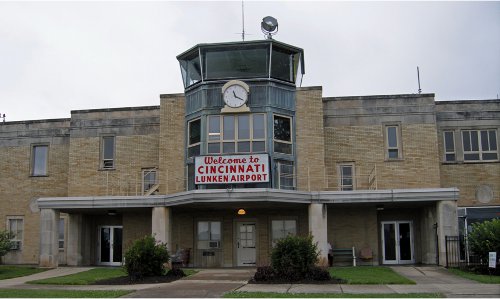
Cincinnati Lunken Airport

The masses enter the aviation age in Harry Gothard's 1937 paintings for Lunken.
Since 1842, the family-owned Verdin Company has manufactured cast bronze bells, carillons, digital bells, tower clocks and street clocks.

Electronic carillons on the repair bench
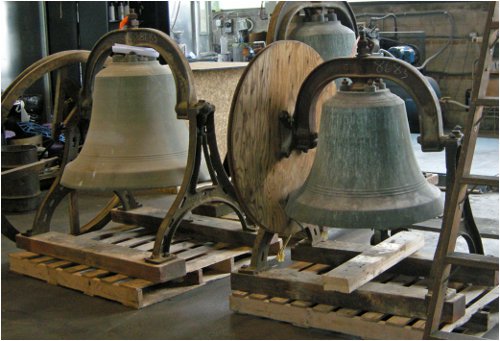
Verdin Company bells
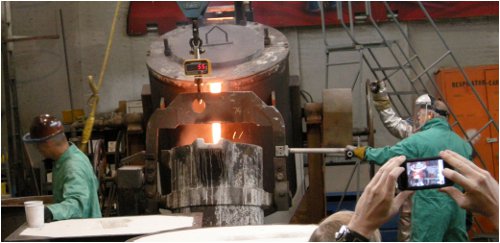
Hot metal, happy tourists, and another satisfied customer.
Back at the hotel I rehearsed my presentation for next day's paper sessions ( flying the company flag is always good to justify the cost of attendance at these things), and wondered for the umpteenth time why we don't offer opportunities for industrial tourism here in the once ambitious city.
After all, Hamilton continues to bear the distinction - unique in the country, as far as I know - of doing it all: from the heaviest of heavy industry (mining excepted) to the most delicate and arcane of researches into biological processes, and a good deal in between.
What other city smelts iron and also advances telerobotic surgery technique?
And yet, consider the following paragraph from the draft Official Plan.
3.1.10 The City's tourism product shall focus on outdoor, cultural, sport and meetings and convention business
That is, everything but our historic strength and specific difference - an oversight which becomes neurotic avoidance in that portion of the OP which deals with cultural heritage policies. Thus we have:
3.4.3 General Cultural Heritage Polices for Urban Areas Downtowns
3.4.3.1 The City includes several downtown areas that are historical centres of the community and typically contain a high concentration of cultural heritage resources and associated historical streetscapes, including buildings, such as town halls, landmark institutional buildings, commercial terraces, churches, railway stations, parks and distinctive residential areas. These downtowns are generally located within the Downtown Urban Growth Centre and the Community Nodes associated with the downtowns of the former municipalities of Ancaster, Dundas, Stoney Creek and Waterdown...
Note that buildings housing industry or manufacturing do not appear on this list -though at the time of its writing a mustard-milling plant and two garment factories were operating within a few blocks of King and James - and still are.
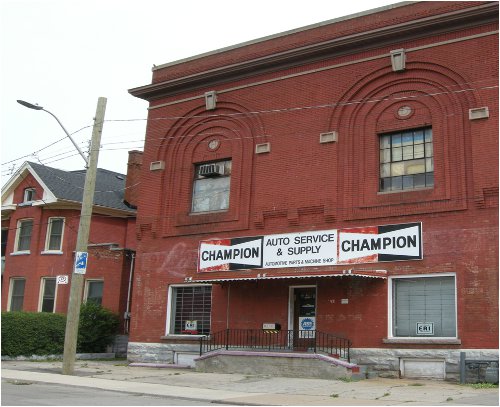
Insignificant building near York and Bay, downtown Hamilton.
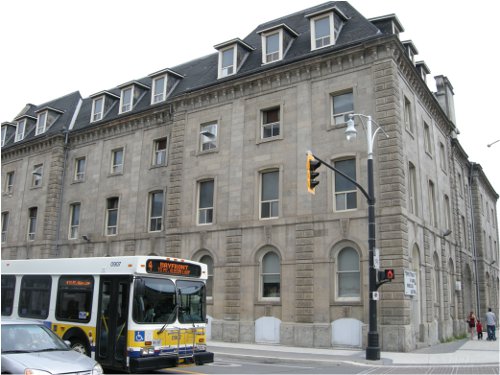
Very large non-landmark building across from Central Library. Rumoured to be associated with manufacturing of some sort.
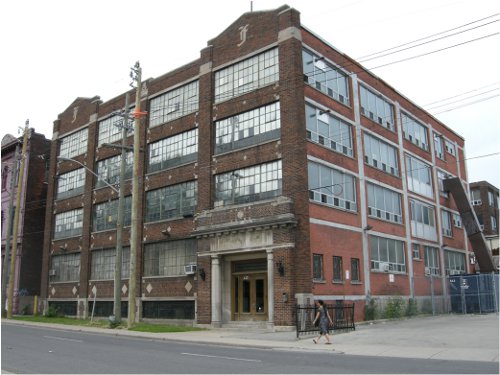
Insignificant building in downtown Hamilton. Also said to be associated with production of some sort. Note entirely forgettable ornamentation of ironwork, stained glass and brickwork at street level.
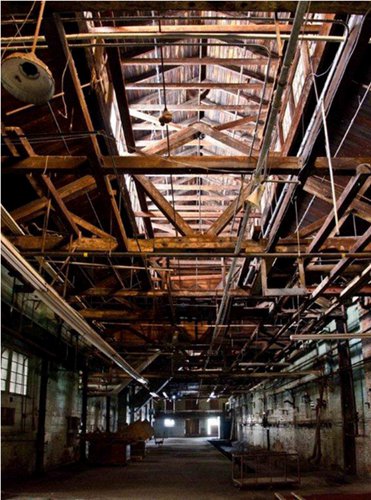
Portion of extra-large non-landmark building in downtown Hamilton. Note culturally irrelevant heavy timber truss construction of interior. Interior image: Carla Mackie.
Well, that's enough of that. But there's a problem here, and it has to do with the value we place on basic production. What is most interesting about these buildings (except the last, which is silent) is what is going on inside them.
There is a notion that we are, or perhaps should be, "post-industrial". Whether we could or should be is a complicated question. But we have not yet been translated entirely into the intangible; nor does the economy consist in nothing but an unbroken chain of promises to pay that are never called in.
No matter how long the chain, at its end someone, somewhere, is taking something from the earth and adding value to it.
Certainly we must try to get into a better position within the ever more closely knit collective cyborg. Assimilate or be assimilated, as it were. Nothing new about that. Continual adaptation has always been our economic path.
But because so much has been forced on us so rapidly in the last three decades, we seem have become averse to choosing change, especially in the public realm. For all the talk of innovation, there is much resistance to real change here.
As Mark Chamberlain rightly points out in a piece over at CBC New Look:
When you think of the city of Hamilton, the amount of time and effort and angst we went through to change a couple of one-way streets to two-way streets, that's an indication that we're not being very innovative.
Dithering around for years over a few two way street conversions is not the mark of an innovative community. Our public art is timid. (That is not to slight our artists. Any visitor to the recent TH&B show knows that they are quite capable of bold and vivid work at any scale.) Traffic management in the central city is utterly obsolete. Sprawl repair in the upper city has been made dependent on light rail development. Most new buildings are architecturally insipid. The more impoverished what is actually built, the more grandiose the compensatory fantasies of a Big Fix.
Meanwhile, real achievements of more prosperous periods, like the Education Centre, are treated with contempt. Adaptive re-use, which would be truly innovative in our context, is rejected - even when we have a fine model of the successful fusion of old and new in the Sopinka Courthouse.
Interim green-up measures for brownfield sites are non-existent, and the urban forest appears to be shrinking rather than growing - though I would certainly like to be corrected on that.
Some of these problems may have no solution - or none that we can afford. But perhaps we can at least resolve our ambivalence about grit and metal and the basics of life in industrial society: one minute proud to be free of the artificiality and pretense that afflict other places, the next chewing our fingernails and worrying that others think we are backward and uncouth and live under a perpetual pall of pollution, and who wants to come to a place like that?
We are what we do. No amount of image-mongering can change that. If we want to dispel a supposed smokestack stigma, we would do better to reposition the admen and deal with the problem head on, Hamilton-style.
We have forgotten, or become apologetic, about who we were and often still are. Although lately the tone of public discourse has shifted a little, and the continuing contribution of basic production is acknowledged, we need to go further. We need to integrate, as the psychologists say.
If we offered visitors - and ourselves - opportunities to get inside our workplaces, to see what we do and make, and what we used to do and make, we might begin to form - and convey to others - a better estimate of our city and our place in the world.
Doors Open Industrial, anyone?
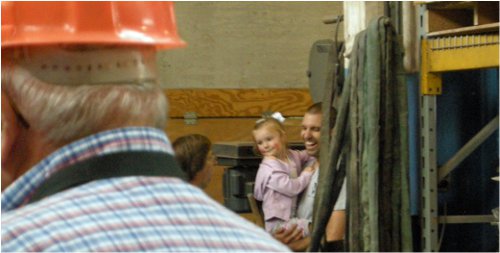
Day pass from the walled gardens of the online world. The plant manager's daughter gets some education at Verdin foundry.
By Summa (anonymous) | Posted June 29, 2012 at 08:20:12
Interesting idea, although it goes without saying that the City should be picking up the tab for any alterations that would have to take place in order to ensure that visitors would be able to pass through safely. Enough workers are injured in the line of work without adding tourists to the mix.
As a lifelong resident of the city I have no problem reconciling heavy industry and high technology, blue collar and white collar, artisan and academic. I feel no shame in any of it.
It is worth noting that Richard Florida has never enthused at length about Hamilton's ecological richness, its fizzy art scene or its abundant of convention capacity. But he has cheered on one of the city's steelmaking giants:
http://www.creativeclass.com/_v3/creative_class/tag/arcelormittal-dofasco
"The dichotomy between industrial and post-industrial service and manufacturing economies is a false one," he writes. "The distinction is between creative and routine work."
By jonathan dalton (registered) | Posted June 29, 2012 at 11:34:35
A good start would be convincing Arcelor Mittal / Dofasco to offer tours to the public. I heard that Dofasco used to, but stopped.
By Undustrial (registered) - website | Posted June 29, 2012 at 18:26:34
How often do we go to see movies with elaborate 3D-rendered Blade-runner-esque landscapes and never stop to appreciate our own? Whether viewed from the escarpment, skyway or elevated parts of Burlington Street, it's pretty breathtaking. I used to treasure long, late-night strolls down along Burlington St, through the burning fires of 'Mordor'....
That being said, Dofasco isn't always open-minded about this stuff. I once got stopped by security and forced to delete all my photos despite never leaving the sidewalk.
By ViennaCafe (registered) | Posted June 29, 2012 at 21:20:15
I read a book once on the decline of US industrial society and the author made a determined effort to do something different: talk to the people who worked in those industrial buildings.
And I see this here, however unintentional. Unique to Hamilton, to my knowledge is a Workers Arts and Heritage Centre: http://www.wahc-museum.ca/
They offer, as part of their display, and when I asked I received copies I could take, walking tours of industrial Hamilton, both early industry and mid-20th century. It is a worth a visit and a donation.
Comment edited by ViennaCafe on 2012-06-29 21:23:39
By lakeside (registered) | Posted June 30, 2012 at 02:35:37
Doors Open Industrial? Yes, please.
The first few times I came to Hamilton was via public school steel mill tours.
An experience I can never forget is when the siren and strobe lights activate, then the explosives that were cast into the concrete bung plug going off, a huge explosion in a giant indoor space, followed by the molten steel running down the trough. When you see it in a video, the world doesn't shake like that.
We saw the finished plasma-breathing coke being pushed from the train cars after a day-long slow anaerobic burn.
Massive pieces of mining equipment being used move the cooled slag to the screening area with its mountainous heaps.
Rose-coloured memories of those field trips are now part of the retro-faux legend that tries to fill in the gaps between a childhood spent elsewhere and current life in my adopted hometown. We definitely got that sort of industrial powerhouse feel that you still hear about today. I always wondered if local kids got the same tours too.
Today,they'd never allow a group of people of any age to experience the bone-shaking reality of steel-making that we did but it sure would be nice to get a look at what happens inside all those corrugated buildings.
Competition, modern marketing and video, 9/11, and the school boards near-elimination of field trips have have all contributed to the disappearance of plant tours.
That said, there was surely a time, before Doors Open, when companies probably thought they'd never want to open things up to the general public. Now many see the value in showing us what's inside.
Comment edited by lakeside on 2012-06-30 02:51:50
By ScreamingViking (registered) | Posted June 30, 2012 at 14:38:42 in reply to Comment 79020
When were the companies still holding tours?
I was in grade school in the late '70s and early '80s, in Hamilton. We never had an opportunity to take a class trip to a steel mill. I would have really loved to experience that.
By ScreamingViking (registered) | Posted June 30, 2012 at 14:44:21 in reply to Comment 79015
The view from Burlington Street, particularly up on the elevated sections between Parkdale and Kenilworth, really shows how vast those industrial complexes are. Quite different from looking at them from across the bay or along the QEW, where they loom large but the visual perspective doesn't convey the same sense of scale and depth.
USS painting many of their buildings blue has changed the look too.
By JMorse (registered) | Posted June 30, 2012 at 20:03:57
I'm in! The industrial heritage and presence in Hamilton played a role in my settling here after growing up in Toronto. The railway, warehouse, and port lands I roamed in my youth are almost gobbled up by condo development. Even then, most were shut down and silent. Here, there is clearly much to learn about, both historical and currently operating.
It seems the common sentiment is almost one of shame regarding the industrial legacy. Granted, it's not all positive having been the source of much pain in recent decades.
I haven't any link through family, work, etc. to the subject, but obviously I'm not alone in my curiosity and interest.
By TreyS (registered) | Posted June 30, 2012 at 20:27:00
I like the view from the Skyway. I've never seen anything close to it. If it were trees and water, so what? What side of the bridge do you think people look at? The Lake or Canada's industrial heartland? If the Lake was more interesting then nobody would have anything to worry about because people wouldn't notice the factories, they'd look on the other side. But no, people look at the factories. it's something to look at because it is amazing. It means jobs and industry. And the last time I checked, the world needs steel to build stuff. It has to be made somewhere. Sorry Little House on the Prairie, nails are not made of wood anymore. And I think your bicycle is of made of steel too.
By kevin (registered) | Posted July 01, 2012 at 09:33:57
This is a another great, overdue idea. Imagine all the retired workers bringing their grandchildren to see the plants where they worked - the engines that drove this country. It might even inspire young people to make things (well), again. The most memorable day tour I've been on was the "trouble" spots of Belfast; not pretty, but gritty and real. I used to deliver bottled water into the bowels of many industrial plants along Burlington St, and it was fascinating. I'd love to be tour guide along the same route. Nice job, Shawn. Awesome photos, too.
By LoveIt (anonymous) | Posted July 01, 2012 at 10:43:07
Good idea, of course.
The bridges, skyskrappers, etc. still need steel. But we should keep in mind that more and more things are done from plastic, fiberglass, rasin and other new materials. Many of them go to the dumps.
The view of the heavy industry from the skybridge is spectacular, but somewhat rusty for today's picture of the modern city.
I would leave some on that picture, buldoze the most ugly into harbour and pour conrete on top of them to build something wonderful for kids. Just dreaming..
By adrian (registered) | Posted July 01, 2012 at 23:32:49
I've always been fascinated by the steel mills and I have dozens of pictures of them. My in-laws live out in the Creek and we're on Burlington Street at least once a week, so I've seen the mills at all times of the year, day and night, and they never fail to fascinate. Most recently I was on the Harbour Queen for the first time, which goes quite close to the mills, and the view from the water offered a fresh look at an amazing sight.
I've never had the chance to get up close, but I'd jump at it if I had one. Doors Open Industrial: I love it, and I bet you'd get a lot of takers across the country for that tour. It'd be an absolutely unique experience.
I'm proud of our industrial heritage and rather than trying to hide the view from the Skyway, I think we should do what we can to work with it. Why not install large industrial sculptures along that stretch of the highway that evoke the mammoth energies and terrific industry that defined Hamilton for decades? Could windmills, installed off-shore but near the mills, provide a clean source of power and act as powerful symbols of a forward-looking city? Or what if we simply illuminated the mills - and the smoke they generate - at night, telling the world that far from being ashamed of our industry, we're proud enough to literally highlight it?
By Undustrial (registered) - website | Posted July 03, 2012 at 12:18:37 in reply to Comment 79078
Little known fact: Stelco actually had plans for a windfarm at their Lake Erie facilities, to help power the plant, but backed out on the deal at the last minute. It was in the last years of the company, and got a little ugly. The old Stelco leadership was known for decisions like this.
As for steel - it's a really dirty, dangerous industry, but one which literally keeps our city standing. The question we have to ask isn't whether we could do without steel, it's whether we're going to import it or make it here. It won't be any cleaner or safer in China, Mexico or Eastern Europe. Putting it "out of sight, out of mind" only means that others will have to suffer with far nastier steel plants.
There are materials (plastic, fiberglass, aluminum, carbon etc) which can replace steel in small amounts, but none which could easily (or cheaply) keep bridges and skyscrapers standing. The only thing which comes close in terms of strength and cost is bamboo, and it doesn't grow well here.
By brendansimons (registered) | Posted July 04, 2012 at 14:46:57
I once suggested that we extend the waterfront trail along the CN line all the way across the city. Map here: http://www.flickr.com/photos/brendansimo... http://www.flickr.com/photos/brendansimo... http://www.flickr.com/photos/brendansimo...
If you walk this route you'll notice three things:
1) The route connects the Bayfront to the Museum of Steam and Technology, and finally closes off a ring of trails around the Bay. 2) There is plenty of space in this corridor for a trail. 3) All of the oldest industrial properties front the railyard. This means beautiful big old brick and limestone buildings. The trail provides a guided tour of our industrial past.
I gather that there is little interest from city hall in pursuing this project (at least, from the councillors and staff I've spoken to). The recent expansion of the Hamilton-Brantford rail trail cost $2 million for 2 km, meaning that the full CN route would cost upwards of $9 million. Too bad, because I really like the idea of a Hamilton History Trail.
By danevans29 (registered) | Posted July 04, 2012 at 15:53:58 in reply to Comment 79179
This is a great idea... not only for the tourism aspect but for the transportation aspect. I would love a nice trail to ride accross the city to work and back.
By slodrive (registered) | Posted July 05, 2012 at 11:15:36 in reply to Comment 79003
It's too bad...for work I've toured that place. Pretty impressive.
By slodrive (registered) | Posted July 05, 2012 at 11:19:51
I've seen industry tourism featured on a TV show. Could be interesting. Here's the link:
By DeepCreek (registered) - website | Posted October 24, 2012 at 00:39:59
Getting clean water is obviously not an easy process. It has to go through multiple steps of treatment which require time, effort, money and prior careful training. However, this is apparently inevitable due to the worldly progression that everyone around the world is encountering. The same goes for the manufacturing industry where activities need to run day and night in order to keep up with the ever-rising demand. This is to the extent of neglecting the physical condition of manufacturing factories as there is just insufficient time to settle trivial matters.
You must be logged in to comment.
There are no upcoming events right now.
Why not post one?